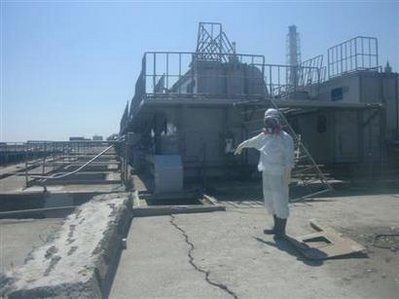
An aide to embattled Prime Minister Naoto Kan said the government's priority was to stop radiation leaks which were scaring the public and hindering work on cooling overheated nuclear fuel rods.
"We have not escaped from a crisis situation, but it is somewhat stabilized," said Goshi Hosono, a ruling party lawmaker and aide to Kan.
"How long will it take to achieve (the goal of stopping the radiation leakage)? I think several months would be one target," Hosono said on a nationwide Fuji TV programme on Sunday.
Plant operator Tokyo Electric Power Co (TEPCO) found a crack in a concrete pit at its No.2 reactor in the Fukushima Daiichi complex at the weekend, generating readings of 1,000 millisieverts of radiation per hour in the air inside.
The leaks did not stop after concrete was poured into the pit, and TEPCO turned to water-absorbent polymers to prevent any more contaminated water from going out.
The latest effort to staunch the flow of radioactive water into the Pacific started on Sunday afternoon. Workers then topped the polymers with more concrete.
"We were hoping the polymers would function like diapers but are yet to see a visible effect," said Hidehiko Nishiyama, a deputy director general of the Nuclear and Industrial Safety Agency.
Officials believe the crack could be one source of the radiation leaks that have hobbled efforts to control the six-reactor complex and sent radiation levels in the sea soaring to 4,000 times the legal limit.
The battle to cool overheated reactors and avoid dangerous meltdowns of the highly radioactive fuel rods has seen workers hose saltwater into reactors, but this has left the facility awash with contaminated saltwater, preventing workers getting closer to the reactors.
Nishiyama said fresh water was now being pumped into No. 1, 2 and 3 reactors using external power, which was more stable than the emergency diesel generators previously being used.
He said the three reactors were now generally stable. TEPCO has said it will scrap at least four reactors once they are under control, but this could take years or even decades.
Japan's crisis has rocked the nuclear industry and the European Union said on Sunday it will affect the fight against climate change as energy policies are reviewed.
Germany and Switzerland have said they will shut older reactors or suspend approvals, China has suspended approvals for new plants, and Taiwan is studying cutting nuclear output.
PM Under Pressure
The 9.0 magnitude quake and tsunami on March 11 has left nearly 28,000 people dead or missing and Japan's northeast coast a splintered wreck. The disaster has hit economic production and left a damages bill which may top $300 billion.
After a three day intensive air and sea search by thousands of U.S. and Japanese forces another 77 bodies were recovered, Kyodo news agency said on Sunday.
Prime Minister Kan is under intense pressure to steer Japan through its worst crisis since World War Two, but after three weeks many Japanese are angry that the humanitarian disaster seems to have taken a back seat to the nuclear crisis.
Unpopular and under pressure to quit or call a snap poll before the disaster, Kan has been criticised for his crisis management.
More than 163,710 people are living in shelters, with more than 70,000 people evacuated from a 20 km (12 mile) no-go zone area the nuclear plant, and another 136,000 people living a further 10 km out have been told to leave or stay indoors.
A field survey by Tokyo University found one of the tsunami waves, which hit coastal city Iwate, was estimated to have reached 37.9 meters in height as it washed timber from sea-level up the slope of a nearby mountain, said Kyodo news agency.
Moves to Stop Power Blackouts
The government has said it estimated damage from the earthquake and tsunami at 16 trillion to 25 trillion yen ($190 billion-$298 billion). The top estimate would make it the world's costliest natural disaster.
Manufacturing in the world's third largest economy has slumped to a two-year low as a result of power outages and quake damage hitting supply chains and production.
General Electric, which helped build the Fukushima Daiichi nuclear power plant will help TEPCO supply electricity in the coming months when demand soars.
Demand for power jumps in Japan in summer due to heavy use of air conditioners. More than 168,500 households in the north are still without electricity after the tsunami.
The government has said it will restrict maximum power use by companies during the hotter months in an effort to avoid further blackouts.
The International Monetary Fund (IMF) said the Japanese economy would take a short-term hit and it could not rule out further intervention on the yen.
Japan's health ministry said on Sunday it had detected radioactive substances higher than legal limits in mushrooms from Iwaki in Fukushima, said Kyodo.
"Grown in Fukushima" has become a warning label for those nervous of radiation which has already been found in some vegetables close to the nuclear plant.
"There is no way we will be able to sell anything," said 73-year-old farmer Akio Abiko. "People in Tokyo are just too sensitive about this kind of thing."
A group of farmers came to Tokyo from Fukushima at the weekend, using Geiger counters to show their produce was safe.
Milk and other staples like mushrooms and berries are still contaminated in parts of Ukraine by radioactive fallout from Chernobyl, 25 years after the world's worst nuclear disaster, Greenpeace said on Sunday.
(Additional reporting by Shinichi Saoshiro, Kiyoshi Takenaka and Yoko Kubota in in Tokyo, David Dolan in Fukushima and Damir Sagolj in Rikuzentakata, David Fogarty in Bangkok, Richard Balmforth in Kiev.; Writing by Michael Perry and Andrew Cawthorne; Editing by Daniel Magnowski)



Reader Comments
to our Newsletter